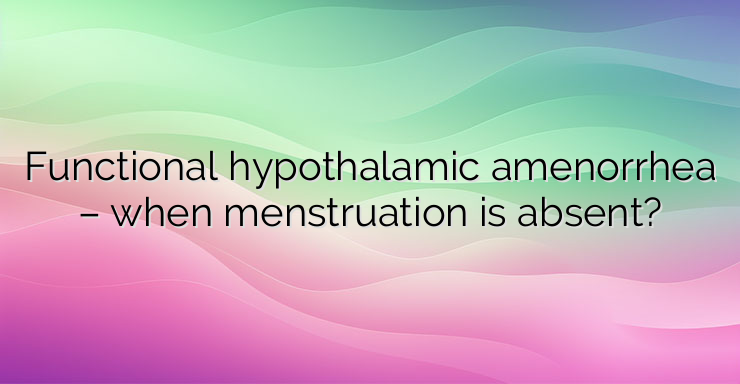Functional hypothalamic amenorrhea is one of the most common types of amenorrhea, accounting for 15-35% of cases. It is a form of chronic amenorrhea (absence of menstruation) in the absence of organic causes. As its name suggests, when the factors that led to this condition are corrected, normal ovarian function is restored. Its pathogenetic mechanism is not fully established, but it is assumed that stress factors, eating disorders and excessive physical activity are among the most common causes. It is characterized by a reduction in the secretion of gonadotropin-releasing hormone, more precisely, its pulsatile secretion and frequency of release from the hypothalamus are disturbed. As a result, the corresponding secretion of the two gonadotropic hormones from the pituitary gland – follicle-stimulating hormone and luteinizing hormone – is reduced. The effect on the ovaries is freezing of folliculogenesis and ovulatory ovarian function. The end result of this is: lack of menstruation and ovulation, and infertility. The condition is very common in adolescent girls who are active athletes or suffer from eating disorders – anorexia nervosa and/or bilimia. Both causes are a kind of stress factor for the body, the hypothalamus being the earliest and specifically the sexual function controlled by it. As a result of chronic stress, the hypothalamic-pituitary-adrenal axis is activated with an increase in cortisol secretion. Hypercortisolemia has been observed in girls – athletes and girls undergoing drastic food diets. In both types, there is activation of the adrenal axis with increased synthesis and production of cortisol, as a stress hormone, and as a result, a reduction in the secretion of gonadotropin-releasing hormone and, downstream, of luteinizing hormone. How do eating disorders and excessive physical activity negatively affect the sex axis? The key to this disorder lies in adipose tissue. It turns out that the level of accumulated fat tissue determines the onset of puberty in adolescent girls. And just as excessive accumulation of adipose tissue negatively affects the sexual axis, so its drastic reduction plays a negative role. Leptin turns out to be the main regulator of this link adipose tissue – hypothalamus. It is a hormone released by fat cells that signals satiety to the brain and specifically the hypothalamus. It also stimulates the pulsatile secretion of gonadotropin-releasing hormone. Research shows that girls with functional hypothalamic amenorrhea have low leptin levels compared to healthy controls. NEWS_MORE_BOX Functional hypothalamic amenorrhea is a diagnosis of exclusion. After rejecting the presence of other organic causes of menstrual cycle disorder, it can be accepted as a diagnosis. Therefore, it is necessary to first rule out pregnancy, take a complete physical and gynecological examination. Her treatment involves correcting the energy balance.It is recommended that girls with eating disorders undergo cognitive therapy in order to correct eating habits and increase body weight. It is very important in such cases that they have the full support of their relatives and friends. In situations of increased physical activity, it is recommended to reduce them and also increase body weight. Psychotherapies are recommended in order to reduce mental workload and stress. The negative health effects of chronic amenorrhea are primarily infertility, delayed puberty, and the long-term effects of hypoestrogenism (chronic exposure to low levels of estrogen)—low peak bone mass and osteoporosis. In conclusion, it can be said that functional hypothalamic amenorrhea is a reversible condition, which, however, poses long-term risks for the woman if it is not detected and corrected in time.


Leave a Reply